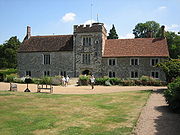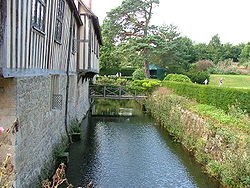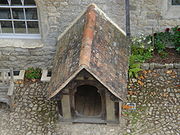
Ightham Mote
Encyclopedia

Manor house
A manor house is a country house that historically formed the administrative centre of a manor, the lowest unit of territorial organisation in the feudal system in Europe. The term is applied to country houses that belonged to the gentry and other grand stately homes...
close to the village of Ightham
Ightham
Ightham is a village in Kent, England, located approximately four miles east of Sevenoaks and six miles north of Tonbridge. The parish includes the hamlet of Ivy Hatch....
, near Sevenoaks
Sevenoaks
Sevenoaks is a commuter town situated on the London fringe of west Kent, England, some 20 miles south-east of Charing Cross, on one of the principal commuter rail lines from the capital...
in Kent
Kent
Kent is a county in southeast England, and is one of the home counties. It borders East Sussex, Surrey and Greater London and has a defined boundary with Essex in the middle of the Thames Estuary. The ceremonial county boundaries of Kent include the shire county of Kent and the unitary borough of...
.
The name "mote" derives from "moot", "meeting [place]", rather than referring to the body of water.
Ightham Mote and its gardens are owned by the National Trust
National Trust for Places of Historic Interest or Natural Beauty
The National Trust for Places of Historic Interest or Natural Beauty, usually known as the National Trust, is a conservation organisation in England, Wales and Northern Ireland...
and open to the public.
Description

Nikolaus Pevsner
Sir Nikolaus Bernhard Leon Pevsner, CBE, FBA was a German-born British scholar of history of art and, especially, of history of architecture...
called it "the most complete small medieval manor house in the country", and it remains an example that shows how such houses would have looked in the Middle Ages
Middle Ages
The Middle Ages is a periodization of European history from the 5th century to the 15th century. The Middle Ages follows the fall of the Western Roman Empire in 476 and precedes the Early Modern Era. It is the middle period of a three-period division of Western history: Classic, Medieval and Modern...
. Unlike most courtyard houses of its type, which have had a range demolished, so that the house looks outward, Nicholas Cooper observes that Ightham wholly surrounds its courtyard and looks inward, into it, offering little information externally.
It was bequeathed to the National Trust
National Trust for Places of Historic Interest or Natural Beauty
The National Trust for Places of Historic Interest or Natural Beauty, usually known as the National Trust, is a conservation organisation in England, Wales and Northern Ireland...
in 1985 by an American
United States
The United States of America is a federal constitutional republic comprising fifty states and a federal district...
businessman, Charles Henry Robinson, who had bought it in 1953. The house is now a Grade I listed building, and parts of it are a Scheduled Ancient Monument
Scheduled Ancient Monument
In the United Kingdom, a scheduled monument is a 'nationally important' archaeological site or historic building, given protection against unauthorized change. The various pieces of legislation used for legally protecting heritage assets from damage and destruction are grouped under the term...
.

Great Hall
Great Hall may refer to* Great hall, the main room of a royal palace, nobleman's castle or large manor house* Great Hall of the People, Tiananmen Square, Beijing* Great Hall of the University of Sydney, Australia* Cooper_Union#The_Great_Hall, New York...
, to which were attached, at the high, or dais end, the Chapel
Chapel
A chapel is a building used by Christians as a place of fellowship and worship. It may be part of a larger structure or complex, such as a church, college, hospital, palace, prison or funeral home, located on board a military or commercial ship, or it may be an entirely free-standing building,...
, Crypt
Crypt
In architecture, a crypt is a stone chamber or vault beneath the floor of a burial vault possibly containing sarcophagi, coffins or relics....
and two Solar
Solar (room)
The solar was a room in many English and French medieval manor houses, great houses and castles, generally situated on an upper storey, designed as the family's private living and sleeping quarters...
s. The courtyard was completely enclosed by increments on its restricted moated site and the battlemented tower constructed in the 15th century. Very little of the 14th century survives on the exterior behind rebuilding and refacing of the 15th and 16th centuries.
The structures include unusual and distinctive elements, such as the porter's squint, a narrow slit in the wall designed to enable a gatekeeper to examine a visitor's credentials before opening the gate. An open loccia with a fifteenth-century gallery above, connects the main accommodations with the gatehouse range.A large kennel was built in the late 19th century for a St. Bernard
St. Bernard (dog)
The St. Bernard is a breed of very large working dog from the Italian and Swiss Alps, originally bred for rescue. The breed has become famous through tales of alpine rescues, as well as for its large size.-Appearance:The St. Bernard is a large dog...
named Dido is the only Grade I listed dog house.
In 1989 the National Trust began an ambitious restoration project which involved dismantling much of the building and recording its construction methods before rebuilding it. The project ended in 2004 after uncovering numerous examples of structural and ornamental features which had been covered up by later additions. It is estimated to have cost in excess of £10million.
A rumour is circulated that during the 19th century a female skeleton was found walled up behind a blocked service door. The door was shown by the Time Team
Time Team
Time Team is a British television series which has been aired on Channel 4 since 1994. Created by television producer Tim Taylor and presented by actor Tony Robinson, each episode features a team of specialists carrying out an archaeological dig over a period of three days, with Robinson explaining...
special No. 21 and was actually a closet. There are no records of a skeleton being found and the rumour has not been entered into the 2004 tour booklet.

Green Darkness
Green Darkness is the 1972 novel by Anya Seton.-Plot summary:In the 1960s, young Celia Marsdon is a rich American heiress who, upon her marriage to English aristocrat Richard Marsdon, goes to live at an ancestral manor in Sussex, England. Shortly afterward, strange things begin to occur —...
also features Ightham Mote as a main setting, using the legend of the walled-up skeleton as a significant plot point.
External links
- Ightham Mote information at the National Trust
- Time Team, a television programme on the restoration of Ightham Mote

